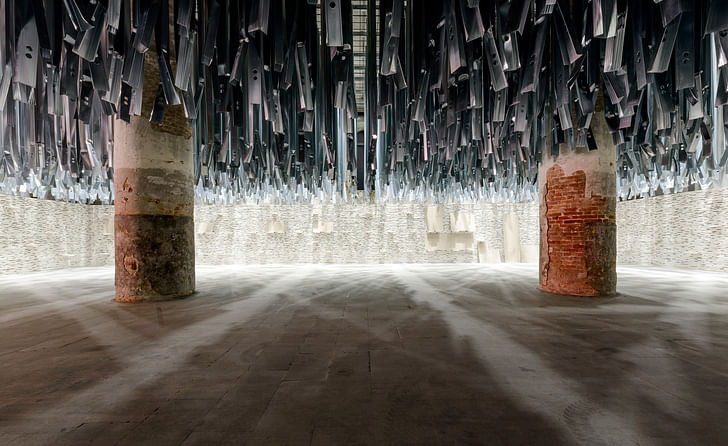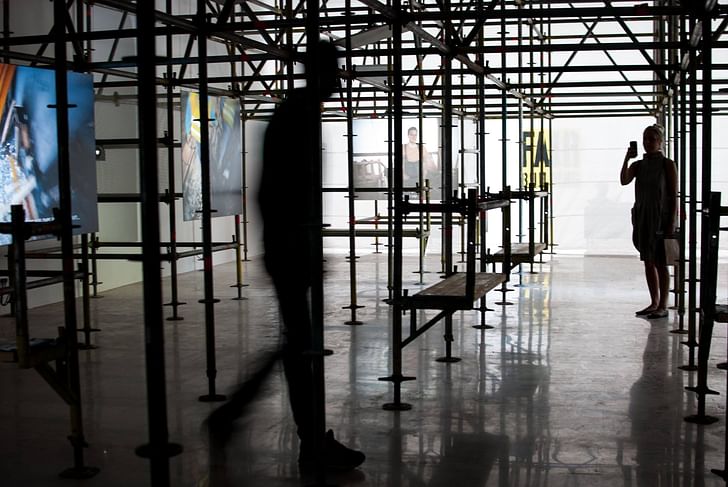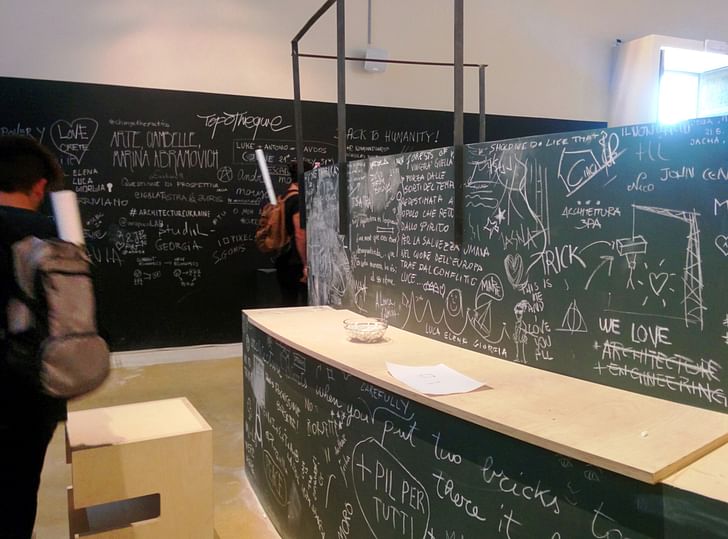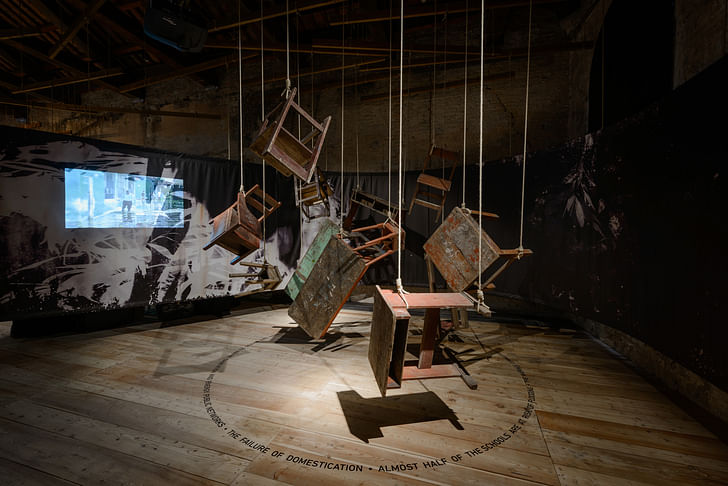

This year’s International Architecture Exhibition at the Venice Biennale feels refreshing. It showcases, for the most part, attempts at real architecture for real people. Titled Reporting from the Front, the Biennale is curated by 2016 Pritzker Prize winner Alejandro Aravena, and has a fresh lineup of new faces and alternative practices. It puts the spotlight on those who work on the ground to prove that architecture can make a difference. As president Paolo Baratta states, the Biennale presents “creativity and hope in the here-and-now, not in some uncertain aspirational, ideological future.”
Aravena’s brief for the 2016 Biennale calls for projects that “are scrutinizing the horizon looking for new fields of action, facing issues like segregation, inequalities, peripheries, access to sanitation, natural disasters, housing shortage, migration, informality, crime, traffic, waste, pollution and the participation of communities.” Reporting from the Front has thus inspired participants to take an active approach in defining the role of architecture today.
Each pavilion has its own interpretation, yet both national and individual participants offer unconventional solutions to complex challenges—they are the true avant-garde. Four broad themes emerge from their responses: subversion, integration, renewal and reaffirmation. Subversion uncovers the uneasiness of the profession in addressing issues potentially beyond its scope. Integration explores how different contexts can come together to formulate solutions. Renewal shows steps “in the right direction”, work that goes beyond the purely aesthetic. Reaffirmation proves that architecture can indeed address difficult complexities in the social, economic and political realms. The themes reveal four different stages where architecture plugs into broader structures, addressing the concerns raised by Aravena. They serve to understand where the profession has come from, and what direction it’s heading toward.
Subversion
The Venice Biennale explicitly calls for instances where architecture is an “instrument of self-government… and a demonstration of the ability of humans to become masters of their own destinies.” The South African Pavilion, at the Arsenale Sale d’Armi, breaks the limits of preconceived design and shows examples in which citizens have actively reclaimed urban space. Poland’s Pavilion also challenges the profession, taking a critical look at the oft-unconsidered industry that enables architecture: construction. Another example is the British Pavilion at the Giardini, which runs along the lines of domestic subversion—albeit more subtly—and hits the nail on the head as it illustrates the country’s housing crisis.guerrilla interventions want to look at the city with new eyes; take whatever is good from the past and use it.
"Cool Capital", the South Africa Pavlion, brings Pretoria to the limelight by challenging the historical interaction between citizens and public space. “Pretoria has a huge political baggage and negative connotation,” curator Pieter Mathews explains, adding that “guerrilla interventions want to look at the city with new eyes; take whatever is good from the past and use it.” The Pavilion features selected works from the Cool Capital platform—“the first un-curated, DIY, guerrilla biennale”—in a marvelously ad-hoc manner. The Pavilion repurposed partitions from Venice’s 2015 Art Biennale, and slotted in with an installation of gifted work and temporary materials. Mathews explains that “creativity is not about money[, but] about looking at what you’ve got and reimagining it.”

In that sense, the work displayed in the South Africa Pavilion democratizes creativity. It opens the city to those willing to reinvent it, and invites citizens to take ownership of the space that is theirs. Three-minute videos showcase examples of guerrilla interventions across Pretoria: some projects leave a legacy while others are more ephemeral, yet all share the premise of minimum intervention for maximum impact. Moving away from Pretoria, Cool Capital has also started to “sculpture-bomb Venice” in the spirit of guerrilla architecture. With a mischievous smile, Mathews confesses: “We’re doing a guerrilla Biennale at the Biennale. We’re ahead of the game.”
We want to show the hidden cost of the architecture businessThe Poland Pavilion, "Fair Building", directly questions architectural ethics. “We know where our food comes from, where our clothes are stitched—why don’t we talk about how our buildings are made? Is it possible to have ‘fair trade’ buildings?” asks co-curator Dominika Janicka. Fair Building places the focus on construction workers and instigates a discussion on the hidden participants of architecture. The Pavilion is divided into two rooms that evidence the industry’s dichotomy. The first room screens videos of the construction industry projected on screens along metal scaffolding. Videos of 15 workers wearing Go-Pro cameras on their helmets are complemented by interviews with 50 others about the realities of working on site. The second room opens into a pristine layout of leather sofas and flat-screen televisions, resembling a sales room for luxury projects.
Other parts of the exhibition confront the realities of the architecture industry’s limits, where the architect comprises a minuscule fraction of a project and construction is the real backstage sweatshop that we fail to acknowledge. “We want to show the hidden cost of the architecture business,” says Janicka, “not only architecture how the user sees it.” The Polish Pavilion steers clear of the judgmental, although the curators feel passionate about declarations like those of the late Dame Zaha Hadid on her work in Qatar. Fair Building wants to have an open discussion, highlighting the problem but also asking: “Is Fair Building possible?”

Integration
The brief for the Biennale asks for projects that respond to a scope that transcends the issues usually addressed by architecture. However, it also makes clear that “architecture is called to respond to more than one dimension at a time, integrating a variety of fields instead of choosing one or another.” Turkey’s Pavilion, at the Arsenale Sale d’Armi, and Greece’s Pavilion, at the Giardini, respond to this by proposing to connect places that are geographically separated but culturally linked. Others that focus on integration are Finland and Germany, primarily discussing the current refugee crisis and the role of their cities in addressing it.
"Darzanà", the Turkey Pavilion, displays a single object: a vessel. Its name, Baştarda, references the hybrid ships characteristic of Turkey and Italy from the eleventh to the nineteenth century. They are ships from no clear place, the illegitimate children assembled with parts of undefined origin. “We want to change the negative connotation of the word,” declares Mehmet Kütükçüoğlu, one of the Pavilion’s co-curators. “So much emphasis is placed in tracing origin today; we see it as one and all.”

The vessel references the current refugee crisis in Turkey, as well as the various waves of migration throughout human history. Parts scavenged from Istanbul shipyards and then transported to Venice via the Mediterranean hang from the ceiling, forming a vessel out of the relationship between solid and void. As Feride Çiçekoğlu, another co-curator puts it, “the Baştarda is not only about architecture, but also about the language and the words. It’s about the journey.” The Pavilion strikes the viewer as a fairy tale suspended in time, yet invites the audience to dig deeper into the meaning of origin and of assembly. What defines our origin? What brings us together?

Greece’s Pavilion also connects its Mediterranean legacy to that of Venice. "#ThisIsACo-op", curated by the Association of Greek Architects, is an experiment in collaboration. Maria Kassola, from the curatorial team, explains the intent arguing that “finding solutions is a collective project, not something you do in your office.” The Pavilion opens up to symmetrical amphitheaters set for debate, surrounded by blackboard walls (and chalk) for visitors to write on.We want this to generate a lot of expectation, of hope; it is a very optimistic project
The process of curating the Greek Pavilion was a convoluted one, with changing directions and the unexpected dissolution of the selection committee. Therefore, the curators have reimagined it as a setting for ongoing conversation, which invites participants and visitors to use it as an open venue. “It would be a dream to have the visitors start an impromptu discussion here,” Kassola says enthusiastically. To that end, the pavilion will host 23 parallel events across Venice and throughout Greece, broadcasted on projections facing the amphitheaters to stimulate debate throughout the duration of the Biennale. The website and hashtags at the Pavilion (many of which provocatively reference Greece’s ongoing refugee crisis) will help build the dialogue, making the event “the beginning of a process, not the end.”
Renewal
The image chosen to lead the 2016 Biennale—of a woman alone, standing on a ladder, overlooking a vast and barren land—is meant to convey a sense of architectural appraisal, taking stock of the current situation, without making a prescriptive statement about how participants might respond to Aravena’s call. Spain’s Pavilion, for instance, samples explicitly from the country’s past to address current challenges, exhibiting instances where architects repurposed ruins from a more prosperous time. "Sarajevo Now", on the other hand, tackles the urban stresses stemming from poverty and crime, and shows how architecture is already reinventing itself.

This year’s recipient of the Golden Lion for Best National Participation, Spain’s “Unfinished”, showcases 55 different projects that have reimagined the unfinished leftovers of “the largest construction enterprise in Spanish history,” as described by co-curator Iñaqui Carnicero. The Pavilion feels open and easy to navigate; visitors wander in-between suspended metal stud frames, lending a playful sequence to the exhibition. Additional projects are displayed in adjacent rooms, with photographs and axonometric drawings in wooden frames that stabilize the metal studs that support them. Every part of the exhibit builds on another, bringing together the many layers of the proposal.
The Pavilion invites multiple opportunities for engagement across media: from a 30-second selfie to the in-depth project descriptions on the website or through the QR codes along the walls, gathered together through the #Unfinished tag. Unfinished also includes a free pamphlet, distributed at the Biennale, two books, and three online publications. “We want this to generate a lot of expectation, of hope; it is a very optimistic project,” says co-curator Carlos Quintáns.
Sarajevo Now, a Collateral Event commissioned by the Matica of Bosnia and Herzegovina, features a retrospective look at Urban-Think Tank’s (UTT) work. Based on their Si/No exhibit that toured Zurich and Munich earlier this year, it gives the feel of work in progress. A corridor demarcated with yellow tape on the floor divides the exhibit: the right-hand side displays UTT’s work throughout the years, and the left-hand side reimagines The People’s Museum for the city today.

Hubert Klumpner describes the idea for the Sarajevo Museum like this: “the museum synthesizes what exists already instead of existing as an autonomous form.” The proposal reimagines the museum typology to make it a place for the people; a place to understand the culture and history of Sarajevo. Everything on the site makes up part of the museum collection—even the building itself, wrapped in a scaffolding shell. “In case you haven’t noticed, the Museum is at the frontline of gunfire—of metaphorical gunfire. It’s at the frontline of architecture and society and culture and politics!” says Alfredo Brillembourg with buoyant enthusiasm, calling for subversion in architecture.
Reaffirmation
In his brief for the Biennale, Alejandro Aravena recognizes that “the always menacing scarcity of means, the ruthless constraints, the lack of time and urgencies of all kinds are a constant threat that explain why we so often fall short in delivering quality.” Several examples across the Biennale display how architects around the world are trying to overcome these challenges. Ireland’s Pavilion (considering usability and dementia), and Peru’s Pavilion (displaying a government-initiated effort to preserve Amazonian languages), both address pressing issues in an understated yet powerful manner. Another example lies in France’s Pavilion, which portrays examples of the unglamorous architecture that makes up the bulk of the country’s urban fabric.It is not only about the installation; it is also about the lessons learned
Ireland’s Pavilion, "Losing Myself", explores the different layers of a building as experienced by people suffering from dementia. Co-curator Niall McLaughlin contextualizes the experience of this condition: “when you have dementia you lose the capacity to remember, to find yourself… a little bit like what happens in Venice after walking around for a couple of hours.” Walking into the Pavilion is at the same time disorienting and fascinating. Speakers suspended from the ceiling play sounds from across different decades, while a dynamic drawing is projected on the floor.

The exhibition, which will tour Ireland to bring attention to the different social issues around dementia, is backed by robust research. “We wanted to address and highlight a challenging issue and report what we have learned. It is not only about the installation; it is also about the lessons learned,” says co-curator Yeoryia Manolopoulou.
Peru’s “Our Amazon Frontline” received a Special Mention for the National Participation category, and explores another very specific issue with significant architectural and political repercussions for the country. “In Peru the frontier has always been the Amazon jungle,” says co-curator Jean Pierre Crousse. The exhibition shows the work of Plan Selva, the first government initiative in the region dedicated to preserve Amazon languages.It’s an architecture that listens, that understands how people live.
In this case, architecture serves as a vehicle for realizing a greater educational project. Modular blocks that are easily transported across the jungle adapt to different climates, topographies and sizes. These combinations, achieved through participatory design processes with local communities, become spaces for the preservation of ancestral culture. Beyond the intent of the educational program, the schools provide a space for social integration, one where indigenous and “Western” traditions come together. “It’s an architecture that listens, that understands how people live. It’s an architecture that is changing the paradigm,” concludes Crousse.

Moving away from comfort
The 2016 Architecture Biennale moves away from comfort. It disputes the role of architecture in society and objects to seeing design in isolation, while avoiding falling into the trap of rewarding feel-good efforts that address simplistic social concerns. The Biennale amplifies voices that have been long unheard, and for that same reason it is also provocative and controversial. It challenges those who place disproportionate emphasis on architecture as an artistic exercise. However, it reminds others that moving beyond aesthetics does not mean disregarding the “cultural and artistic dimensions that already belong to our scope”.
In that spirit, this Biennale is also marked by a keen interest in encouraging participation and generating debate, whether by interactive installations or online collaborative tools. Beyond the Giardini and the Arsenale, other Pavilion Collateral Events make Venice into a living architectural exhibition.
Architecture is evolving as a discipline, expanding its frontiers and boldly embracing complex issues beyond its scope. The 2016 Venice Biennale cements that change and places architecture at the center of reimagining the many layers of our global present. It encourages transformation and exploration, and does not shy away from asserting its ground. Aravena has captured a pivotal moment for the discipline and laid the ground for what is to come. The Front is multifaceted, encouraging and exciting.
Find more coverage of the 2016 Venice Architecture Biennale in the News and Features.
Architect turned social impact consultant. Fascinated by untapped innovation and chaotic cities. Interested in the role of design as a catalyst for development. Loves discovering unexpected interactions between people and place. Originally from Bogotá, Colombia; has lived in the US, Italy ...
4 Comments
How do people actually view Aravena's work knowing that he willingly doesn't pay his interns so that learning to be a socially conscious architect at Elemental is only within reach for the rich lucky few and not students/graduates from within the poorer communities that could actually really benefit from his know-how.
"Architecture is evolving as a discipline, expanding its frontiers and boldly embracing complex issues beyond its scope."
If Donald Trump where an architect.
Completely agree with you, @randomized. It is a problem that is endemic to the discipline and that requires work at all levels (employer, employee, universities, etc.) to be alleviated. In spite of this, however, the Biennale does succeed in allowing new voices, many of which pay decent wages to their employees, ironically, to show how architecture can be done in a different way.
Well said randomized!
Block this user
Are you sure you want to block this user and hide all related comments throughout the site?
Archinect
This is your first comment on Archinect. Your comment will be visible once approved.